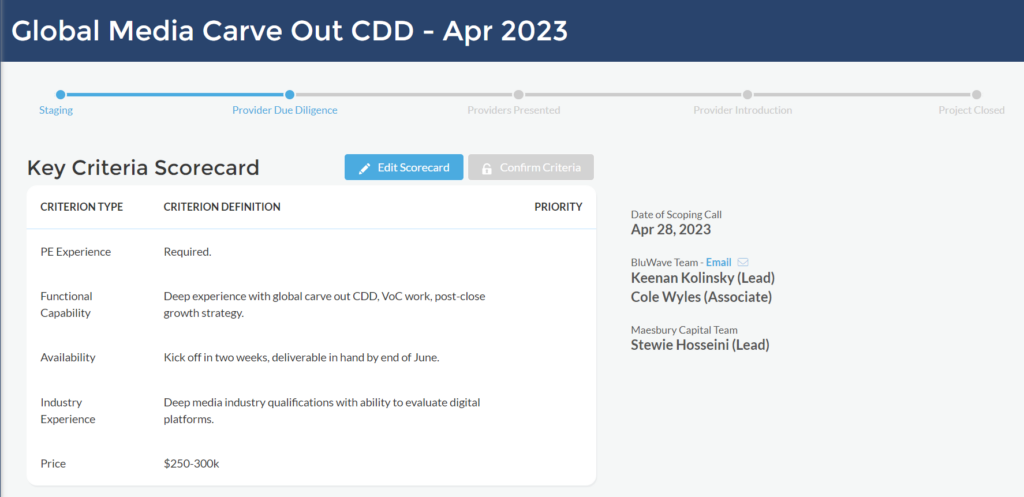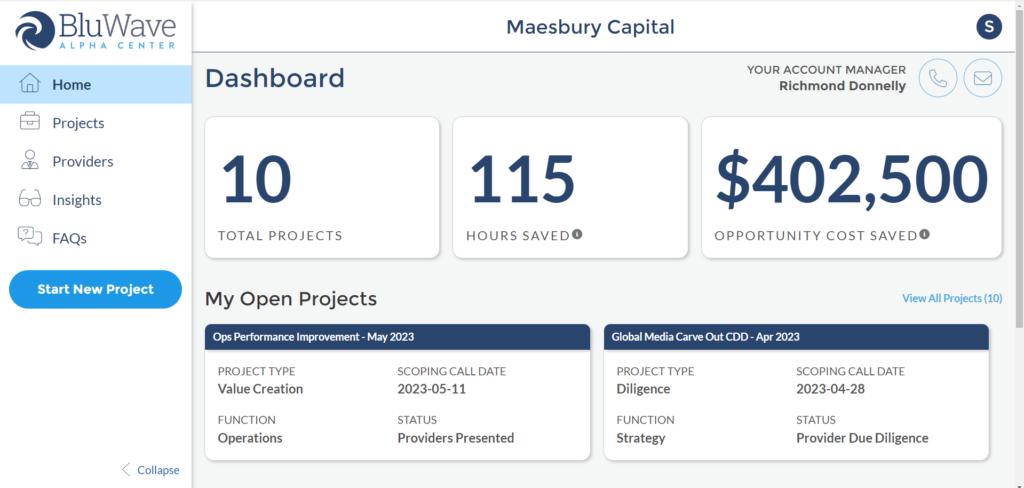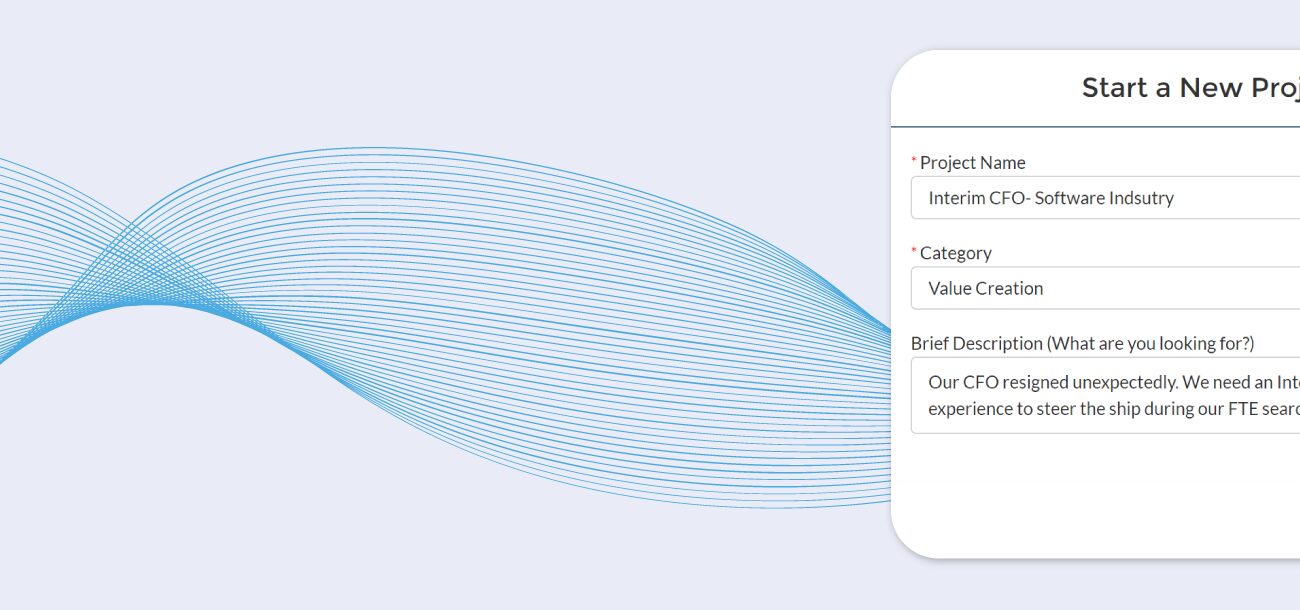Need: Value Creation
Streamlining Data Insights: Creating a Real-Time Dashboard Solution
Service Area: Business Intelligence and Analytics
Client Type: Buyout PE Firm
Service Provider Type: Data Analytics and Visualization Firm
Industry: Utilities
A company in the field services industry faced challenges with managing and extracting valuable insights from their vast amount of data. With data spread across 15 different sources, the client lacked a centralized view and struggled to gain meaningful intelligence. They sought the expertise of an analytics and visualization firm to build a scalable dashboard solution that would integrate multiple disparate sources and provide real-time insights.
The client required a partner who could assist in organizing and integrating data from programs including Microsoft XL, ServicesApp, Salesforce, Paycore and ARI. The aim was to create a data warehouse and develop a user-friendly, real-time dashboard that would consolidate the data and provide actionable insights.
BluWave connected the client with a data analytics and visualization firm experienced in handling complex data integration and visualization projects. The service provider worked closely with the client to understand their data sources, requirements and desired outcomes. They developed a comprehensive plan to organize and clean the data, integrate it into a centralized data warehouse and create a real-time dashboard solution.
The collaboration between the client and the data analytics and visualization firm resulted in the successful creation of a scalable and user-friendly dashboard solution. The integrated data from multiple sources provided a comprehensive view of the company’s operations, enabling data-driven decision-making. It also empowered the client with valuable insights and intelligence to monitor key performance indicators, track progress and identify opportunities for improvement.
The positive experience with the service provider led the client to consider future collaboration for the next phase of the project. The reliable and effective solution provided by the service provider demonstrated their expertise and commitment to delivering high-quality data analytics and visualization services.
We had a great experience with the service provider and we may hire them for the next phase of the project.
-Senior Vice President at the PE Firm
Unlocking Organizational Success: The Role of Leadership Coaching
Effective leadership lies at the heart of any successful business. The ability to guide, motivate and inspire teams is what separates great leaders from the rest. But these skills don’t just appear overnight; they require nurturing and development, which is where leadership coaching comes into play.
Leadership coaching serves as a compass for potential leaders, helping them navigate the complexities of modern business environments. By partnering with third-party resources who specialize in this exact service, your top managers, directors and executives can take their teams to the next level.
Let’s discuss how the exact-match third parties in the Business Builders’ Network can help you solve this exact problem.

The Benefits of Leadership Coaching for Organizations
Leadership coaching offers far-reaching benefits that ripple across an organization. It has a profound impact on leadership development, employee performance and overall organizational growth.
Enhancing Leadership Development
Leadership coaching shapes leaders to be more self-aware, enabling them to tap into their full potential. It’s not a one-size-fits-all process. The goal is to tailor the journey to each individual’s unique strengths and areas of improvement.
The personalized nature of coaching encourages deeper introspection and a greater commitment to professional growth. This individualized approach is more likely to yield effective, long-lasting results.
Improving Employee Performance
The effect of effective leadership transcends the leader themselves. It extends to the performance and job satisfaction of their teams. Leaders who have undergone coaching are better equipped to engage and motivate their teams, fostering a positive work culture and higher productivity. Leadership coaching is not just about developing leaders; it is also a vital strategy to increase your company’s value.
Driving Organizational Growth
The innovative thinking and decision-making prowess fostered by leadership coaching can be pivotal for success. Leaders, shaped by coaching, can inspire their teams to break new ground and achieve their fullest potential. This cumulative effect of individual improvements significantly contributes to organizational growth.
Strengthening Communication and Collaboration
Effective leadership coaching can significantly enhance communication within teams. It also fosters a culture of collaboration built on mutual trust and respect, leading to more productive and synergistic cooperation.
Key Components of Effective Leadership Coaching Programs
A successful leadership coaching program stands on a robust foundation of clear goals, personalized development plans, continuous feedback and accountability.
Clear Goals and Objectives
Defined coaching goals serve as a roadmap for success. These goals, when aligned with organizational objectives, provide a sense of direction and focus for the leader being coached. The clarity offered by these goals helps ensure the coaching process yields effective, measurable results.
Individualized Development Plans
Leadership coaching should not be a one-size-fits-all process. It should be tailored to individual needs and aspirations. Personalized development plans ensure that coaching interventions are targeted and effective, addressing specific areas of growth and improvement.
Ongoing Feedback and Support
Feedback serves as the backbone of any successful coaching relationship. It provides insights into the leader’s progress and areas of improvement, thus spurring further growth. The role of the coach does not end with feedback. Ongoing support and mentorship from the coach are crucial to sustaining leadership development efforts.
Accountability and Measurement
Accountability is a vital aspect of a coaching relationship. Measuring progress and outcomes helps track the effectiveness of coaching initiatives and provides a clear picture of whether goals are being met.
Strategies for Implementing Leadership Coaching Programs
Implementing a successful leadership coaching program requires a strategic approach, right from identifying coaching needs to selecting qualified coaches and establishing a supportive coaching culture.
Identifying Coaching Needs
Understanding the leadership development needs of an organization is the first step in implementing a successful coaching program. These needs can be identified through various tools, including 360-degree feedback reviews, performance assessments and employee surveys.
Selecting Qualified Coaches
Selecting the right coach is crucial to the success of the coaching initiative. Coaches should be experienced, credentialed, and their coaching philosophy should align with the organization’s culture and values.
Working with a exact-fit third-party can save you wasted time and money but connecting with the exact resource you need for your specific situation.
Establishing a Supportive Coaching Culture
Creating an organizational culture that values coaching and continuous learning can greatly impact the success of leadership coaching initiatives. Leaders should demonstrate their endorsement of coaching by participating in it themselves and sharing their experiences.
Integration with Leadership Development Initiatives
Combining coaching with other learning opportunities such as workshops and seminars provides a comprehensive approach to leadership development. This integration ensures practical application of new knowledge and skills in the workplace, reinforcing the learnings from leadership coaching.
Unlocking your organization’s full potential through effective leadership coaching need not be an overwhelming task. BluWave’s expert research and operations teams can connect you to the perfect service provider to help navigate this transformational journey. Connect with BluWave today and let us help you unlock the full potential of your leaders.
Investment Strategies, Bridging Valuation Gaps, Leveraging AI: VP Forum
BluWave welcomed a group of accomplished thought leaders June 22 for its latest VP forum.
The panel, comprised of Lauren D’Amore of Prelude Growth Partners, Mackenzie Laudel of Shamrock Capital Advisors and Yan Levinski of Trivest Partners was moderated by BluWave founder & CEO, Sean Mooney.
The experts delved into three critical aspects of the investment landscape: effective sector ideation strategy, bridging the buyer-seller valuation gaps and leveraging AI in the investment process.
Here are some of the key takeaways:

Summary Takeaways
- Investment firms increasingly employ long-term thematic exploration for ideation, aiding their decision-making process and enabling differentiation.
- The dynamic market environment necessitates innovative approaches like earn-outs to bridge buyer-seller valuation disparities.
- AI is still nascent in the investment arena, with its integration and application varying greatly across firms based on their unique sectoral needs and strategic requirements.
This event was conducted with the Chatham House Rule in place.
Expanding on Sector Ideation Strategy
The panelists stressed the importance of leveraging industry, consumer and market trends to formulate effective investment strategies. To this end, firms are differentiating themselves by immersing in a particular theme or sector over multiple years. This not only lends a unique perspective to every investment opportunity but also leads to more informed and strategic decision-making.
The panel also touched upon the importance of a focused investment universe. Some firms are moving away from a broad-spectrum approach to concentrate on mid-market, founder or family-owned businesses. This narrower focus facilitates a deep understanding of potential investments and leads to higher quality deal flow.
CASE STUDY: How BluWave Enabled Massive Turnaround of Family-Owned Business
Bridging the Buyer/Seller Gap
As the market continues to fluctuate, there’s been a shift in deal flow, with some firms noticing a lean toward growth equity deals. These deals offer more structural levers to pull during negotiations, proving to be advantageous in the current economic climate.
READ MORE: PE Market Analysis: Growth Strategy for Business
In response to sellers’ high expectations, firms have had to adapt and innovate their negotiation strategies. Earn-outs, previously less favored due to their potential complexity, are now being used more frequently to bridge valuation gaps. Firms are also exploring other attractive deal structures, such as rollovers and seeking to simplify negotiations by taking representations and warranties off the table.
Embracing AI in the Investment Process
The conversation on AI’s role in the investment process revealed a mix of approaches. Some firms have proactively set up AI task forces to explore how the technology can impact their portfolio companies and be integrated into daily workstreams.
READ MORE: AI Data Analytics: Business Intelligence Tools
But as mentioned above, the adoption of AI varies across firms. Some admitted to falling behind, expressing a need to engage AI consultants to bridge the knowledge gap. Conversely, others haven’t yet prioritized AI due to their investment in sectors where it has less relevance.
Whether you’re navigating investment strategies, bridging valuation gaps or exploring the potential of AI, the landscape of investing is continually evolving.
As these conversations unfold, BluWave remains committed to connecting you with the exact-fit resources and insights to navigate this ever-changing environment. To learn more, or to start your project, set up a scoping call with our research and operations team.
In the Know: Unleashing Potential with Buy and Builds
The Power of the Buy-and-Build Strategy
Companies are always on the lookout for innovative growth strategies. One approach that has proven particularly effective is the buy-and-build strategy. In this model, a holding company acquires multiple smaller firms and integrates them into a larger entity.
The strategy is akin to a swift game of chess where acquiring and integrating companies quickly can help achieve a stronghold in the market. Moreover, this model can be replicated across cities, allowing for exponential growth and market domination.
A Unified Structure with Unique Entities
The brilliance of the buy-and-build strategy lies in its structural design. At the top is the holding company, equipped with a C-suite, while each smaller company has a General Manager. This organizational structure ensures a balance of central control and local management.
All these entities under the holding company umbrella share standardized features such as technology, financials, and IT systems. It’s like seeing a network of car washes or dental practices, each maintaining its unique brand while operating under a unified and efficient system.
Creating Value Through Strategic Moves
The buy-and-build strategy offers various avenues for value creation. For example, it can be beneficial to conduct a market study and IT due diligence during the acquisition process to ensure seamless integration. This approach also offers opportunities for cost savings through shared services or offshoring certain operations.
Another important facet of the strategy involves standardizing sales functions and integrating finance and accounting systems. It not only streamlines operations but also sets the stage for a robust reporting structure.
Overcoming the Challenges
While the buy-and-build approach provides numerous advantages, it’s not without its complexities. The integration process can be a significant challenge, requiring meticulous planning and execution. Likewise, maintaining focus on the core business amidst rapid acquisitions is crucial. With the right support and expertise, though, these obstacles can be overcome.
In this regard, BluWave can be an invaluable partner. We connect you with service providers specializing in buy-and-build strategies to help tackle integration challenges, evaluate potential acquisition targets and ensure your core business stays the focus amid rapid expansion.
The buy-and-build strategy presents a powerful path to rapid expansion and market dominance. With the right expertise and resources at hand, businesses can navigate the inherent challenges and harness the full potential of this approach.
As you embark on your buy-and-build journey, consider BluWave as your strategic partner in growth. Contact us today to discover how our network of providers can support your vision and unlock your business potential.
Navigating Executive Team Assessments: A Brief Guide
Understanding your executive team’s dynamics, strengths and areas for development is pivotal to your company’s success. Executive team assessments can play a crucial role in this understanding, aligning the leadership team’s skills, behaviors and performance with the strategic goals.
If you’re considering an executive team assessment, BluWave is equipped to connect you with top-tier resources to facilitate the process.
Let’s dive in to better understand what it might look like when you engage a world-class third-party to help.

The Role of Executive Team Assessments
Executive team assessments contribute significantly to crucial business decision-making processes. They help determine hiring decisions, promotions and leadership development strategies. More than that, these assessments shape an organization’s culture, fostering a climate of engagement and transparency.
READ MORE: Unlocking Organizational Success: The Role of Leadership Coaching
Understanding Executive Team Assessments
The primary objectives of executive team assessments are multifaceted. They serve to comprehend team dynamics, assess leadership performance and identify strengths, weaknesses and potential growth areas within the team and individual leaders. The insights gleaned can be instrumental in enhancing team cohesion, clarifying roles and responsibilities, facilitating personal growth, improving leadership capabilities and driving successful succession planning.
Behavioral Analysis
Behavioral analysis provides a method for understanding the behavior, motivations and interaction styles of team members. By scrutinizing these elements, companies can optimize team dynamics, improve communication and facilitate effective decision-making processes.
360-Degree Feedback
The 360-degree feedback process involves gathering performance-related feedback from an employee’s subordinates, peers, superiors and sometimes even external stakeholders. It’s an excellent way to identify blind spots, areas of strength and opportunities for development, contributing to improved performance and higher employee engagement.
Performance Evaluation
Performance evaluations involve reviewing an individual’s job performance and productivity to understand their efficiency. The results of these evaluations can inform promotions, salary increments, layoffs and training needs, offering a robust dataset for assessment.
Personality Tests
Personality tests can help you understand different personality types and how they interact. Moreover, by ensuring that the leadership team adheres to a similar set of values, organizations can maintain consistency in decision-making, operations and company culture.
Alignment with Business Goals
Assessments provide an opportunity for reflection and alignment, ensuring that individual and team efforts contribute to company goals. Through the integration of org chart planning, businesses can gain vital insights into key roles, reporting relationships and team interdependencies.
The Significance of Assessment Results
The results of an executive team assessment can shape professional development plans, improve team dynamics, refine leadership strategies and inform strategic decisions. Incorporating HCM systems software can streamline performance tracking, goal management and feedback collection, further enhancing the assessment process. The role of feedback in the assessment process is instrumental in improving overall organizational performance and fostering a culture of continuous growth and learning.
READ MORE: AI Data Analytics: Business Intelligence Tools
In conclusion, executive team assessments provide invaluable insights into your leadership team’s capabilities and dynamics. They offer a foundation for making informed decisions and fostering a culture of transparency, engagement and continuous growth.
Undertaking an executive team assessment might appear complex, but the rewards of enhanced team performance, strategic alignment and improved decision-making are immeasurable. The BluWave research and operations team is here to connect you with an exact-fit service provider to help you navigate this crucial journey.
How BluWave Enabled Massive Turnaround of Family-Held Business
Service Area: Interim Executives (CFO and COO)
Client Type: Family-Owned Business
Service Provider Type: Specialized Interim Executives
Industry: Industrial Distribution and Services
A multi-generation family-owned business faced significant challenges due to declining financial performance and market dynamics. The company also suffered a cyberattack that exposed weaknesses in its IT infrastructure. Recognizing the need for help, ownership sought external expertise to guide them through a comprehensive turnaround.
The business grappled with challenges related to its profitability and internal capacity. The cyberattack highlighted the urgency of implementing an effective IT infrastructure and strengthening the leadership team. An outside advisory board, hired by the family, immediately recommended that a multifunctional team with interim CFO and COO turnaround skills was crucial. The objective was to streamline operations, reduce costs and create a sustainable foundation for renewed growth in order to rebuild value for the family and company stakeholders. Trusted advisors introduced the family to BluWave.
BluWave sprung into action, first taking time to understand the unique situation and the factors needed for success. BluWave then swiftly matched the family business with a highly experienced interim CFO and COO duo from the BluWave Network who understood the complexities of the company’s industrial markets and possessed a background in turnaround and operational performance improvement. Because of the ready-to-go nature of the PE-grade, pre-vetted Business Builders’ Network, BluWave was able to introduce the perfect fit executives to the company’s family ownership within a single business day.
The transformative efforts led by the interim CFO and COO turnaround team resulted in significant improvements in profitability and operational efficiency. The company quickly took action to stabilize and reinvigorate revenue and optimize human capital, which increased EBITDA from approximately breakeven to more than $10 million in less than 18 months. The cultural shift toward performance and accountability empowered the employee base, enabling them to rise to the challenge and drive positive change throughout the organization. The family was then sold the business to a top private equity firm at a nine-figure valuation.
The collaborative partnership between the family, the interim CFO and COO combo and BluWave facilitated a comprehensive turnaround, leading to increased profitability, operational efficiency and a transformed organizational culture. The company continues to thrive under new leadership, supported by the foundation laid during the turnaround engagement. In fact, the current full-time CFO and the former turnaround interim CFO connected by BluWave keep in touch to this day.
There had to be a tremendous amount of change within the leadership team because we were driving a culture of change toward performance and profitability. They were invigorated by the accountability they saw and the opportunity, and they rose to that challenge.
-Turnaround Interim CFO
Operating Partners’ Forum: Leveraging AI for Data, Analytics
How are private equity firms and their portfolio companies leveraging data and analytics to transform their business landscape? What are the emerging trends in AI and machine learning? These were the central themes June 13 in the latest BluWave-hosted PE Operating Partners’ Forum.
Our esteemed panelists, Tye Howell of Blue Point Capital Partners, Gregory Kegeles of Newlight Partners and Mark Steenhoek of The Stephens Group, LLC. teamed up for this insightful event.
Here’s are some of the key takeaways.
Summary Takeaways
- View data as the new oil, demanding the investment of money, skills and experience to extract value
- Foster a culture of data usage and analytical rigor in portfolio companies
- Invest in data and analytics both internally and at portfolio companies
- Be a catalyst for change and push companies toward a more data-driven approach
- Identify and leverage the right people to lead the data and analytics transformation journey
- Understand and stay ahead of emerging trends in AI and machine learning, such as generative AI and conversational analytics
This event was conducted with the Chatham House Rule in place.
Harnessing the Power of Data and Analytics
The panelists shared insights on how data and analytics are transforming the private equity landscape. They emphasized the importance of evolving toward a data-driven culture to drive tangible results. They said it’s essential to be rigorous and proactive about this during both due diligence and value creation phases.
Fostering a culture of data usage in portfolio companies was also underscored, with a focus on the push-and-pull dynamics of growth equity. Firms are often seen as catalysts for change, nudging portfolio companies toward sophisticated reporting and analytics.
The Impact of People and Learning Curve
People are critical to this transformation journey, according to the panelists, particularly in managing the pace of technological advancements. Developing an effective learning curve, choosing the right leaders and even outsourcing certain operations are critical factors in successful data and analytics implementation.
Emerging Trends in AI and Machine Learning
The discussion later veered toward the exciting prospects of AI and machine learning in the private equity space. Generative AI, with its potential applications in quality assurance, marketing and customer support, was discussed. The panelists also expressed interest in the advancements in conversational analytics and low-code, generative support technologies.
When you’re ready to harness the power of data and analytics like the top PE firms, contact BluWave to set up a scoping call with our research and operations team. Whether navigating the complex landscape of data and analytics, managing your workforce or any other business building services, we have an exact-fit solution for you on standby.
Streamline Your Business-Building Processes with the BluWave Alpha Center
At BluWave, we understand the challenges that proactive business leaders face in finding and engaging with top-tier service providers. That’s why we’re excited to introduce the BluWave Alpha Center, a cutting-edge portal designed to streamline your third-party sourcing, project management and data insights processes.
This AI-driven platform empowers private equity firms, portfolio companies, and private and public businesses to stay ahead of the curve and be at the forefront of modern value creation.
“We are excited to introduce the BluWave Alpha Center, a game-changing platform that empowers private equity firms to accelerate their business-building efforts,” said Sean Mooney, a former PE deal partner and BluWave’s founder and CEO.
Enhanced Collaboration for Maximum Efficiency

Collaborating effectively across teams is crucial in today’s fast-paced business landscape. With the BluWave Alpha Center, you can ensure that your entire team is on the same page. Our platform provides a centralized hub for insights, intelligence and white-glove service, facilitating seamless teamwork. From tracking evaluation processes to scheduling meetings, the Alpha Center simplifies collaboration, ensuring that everyone is working toward a common goal.
Accelerate Your Project Kickoff

In the private equity industry, time is of the essence. The Alpha Center enables you to kick off searches to get connected with the exact PE-grade third parties you require at the exact time you need them. By accessing your Alpha Center account, you can submit high-level criteria to our Research & Operations team and schedule scoping calls with ease. Our best-in-class third-party resources are just a few clicks away, allowing you to accelerate your project kickoff and make progress at the speed of private equity.
Efficient Project Management Made Easy

Managing projects efficiently is key to achieving success. The Alpha Center provides powerful project management tools that simplify the process and enable you to make informed decisions faster. Evaluate service providers, manage onboarding processes and track progress from initial review to contract signings all within a single platform.
This streamlines your project management, saves time and ensures that your deal processes stay on track, aligning with your key objectives and improving outcomes.
Centralized Data Management for Better Insights

Data management is often a challenge, with valuable information scattered across different platforms. The Alpha Center acts as a comprehensive repository, bringing together all your project insights into one place. Catalog projects undertaken through BluWave, access information on providers and capture feedback on past performance.
This centralized tool ensures that you can easily search and share valuable insights across your organization, reconnect with previously vetted resources and facilitate informed decision-making.
Real-Time Insights and Market Comparisons
Stay informed and benchmark your performance with real-time insights and market comparisons. The Alpha Center provides dynamic quarterly updates and detailed reports on project trends, the Value Creation Index and rising priorities in the industry.
Compare your personalized dashboard with these insights to ensure that you’re aligned with the market and leveraging the full potential of your third-party engagements.
The BluWave Alpha Center is more than just a platform – it’s a game-changer for private equity firms and businesses looking to optimize their business-building processes. With enhanced collaboration, accelerated project kickoff, efficient project management, centralized data management and real-time insights, the Alpha Center empowers you to make informed decisions, drive value and stay ahead of the competition.
“We’ve been working with a group of top PE firm beta users, taking their feedback and updating what will be a continually evolving resource,” BluWave Head of Technology & Insights Houston Slatton says. “We’re excited to support existing clients and welcome new ones to the next generation of BluWave.”
Discover the power of the BluWave Alpha Center by scheduling a demo today and unlock the full potential of your business-building strategies.
John Huhn, Compass Group Equity Partners | Unlocking Success: The Power of Persistence in PE
HR Carveout Assistance for Lower-Middle Market PE Firm
Service Area: HR Carveout
Client Type: Lower-Middle Market PE Firm
Service Provider Type: Specialized HR Firm
Industry: Financial Consulting
A lower-middle market PE firm required an HR consultant experienced in HR carveouts to support their project. The client needed assistance in negotiating a Transition Services Agreement (TSA) within a three-week timeframe and guidance in managing the interim transitions of insurance, benefits, and payroll.
The client was undergoing an HR carveout involving a tech/SaaS business with upwards of eight figures in ARR. The carveout involved merging two businesses previously combined by another PE firm, with the client acquiring one segment. The client sought an HR consultant to provide expertise in negotiating the TSA and managing the interim transitions.
BluWave promptly presented the client with several options of specialized HR firms experienced in carveouts. The client engaged a consultant with deep knowledge in their niche. The service provider worked closely with the client to negotiate a robust TSA and provided guidance on managing the interim transitions of insurance, benefits and payroll.
With the HR consultant’s help, the PE firm successfully navigated the HR carveout process. The service provider’s expertise and proactive approach facilitated a seamless transition of insurance, benefits and payroll, while the negotiated TSA provided a solid foundation for post-close operations.
“She was very flexible with the mandate given the carveout nature of the opportunity, and she stepped up to do more when asked. The service provider is very responsive – she always makes time to discuss the company and provide updates.”
-PE Firm Vice President
Maximizing Customer Retention: Strategies for Loyalty, Long-Term Relationships
What is Customer Retention?
Customer retention measures how well a business maintains its customer base over a specific period. It’s an important metric because it is often more cost-effective to retain existing customers than acquire new ones.
When customers consistently choose your brand over competitors, they bring repeat business, provide valuable feedback and often become brand advocates.
Achieving high customer retention isn’t easy, though. It requires careful strategizing, meticulous execution and continuous improvement. This is where third-party resources can make a significant difference. Partnering with experts or leveraging cutting-edge tools can save you valuable time and resources.
Whether it’s designing an attractive loyalty program, implementing effective CRM systems or refining your customer experience, industry specific service providers have experience and expertise you need.
Let’s dive deeper into customer retention and how it can help your business.

Understanding The Importance Of Customer Retention
Building customer loyalty is a critical element of customer retention. The value it brings to business growth is immense as loyal customers often translate to repeat business and referrals. There are several key factors influencing customer loyalty, including product quality, customer service and overall customer experience.
Effective customer retention strategies play a pivotal role in fostering long-term relationships. They involve an array of initiatives ranging from loyalty programs to personalized customer engagements. Examining successful case studies can provide a insights for companies looking to improve retention.
READ MORE: Voice of Customer Process: Methodologies for Better Service
Implementing Customer Loyalty Programs
Customer loyalty programs are designed to incentivize repeat business. There are different types of loyalty programs, each with its own benefits. For example, a points system might encourage frequent purchases, while a tiered system could inspire larger transactions.
READ MORE: How To Analyze Sales Data: Tools, Examples, KPIs
When designing a customer loyalty program, several key considerations come into play. These include understanding your customers’ preferences, setting clear and achievable rewards and ensuring the overall process is straightforward and accessible. Implementing and managing these programs effectively can have a significant impact on customer retention.
Enhancing The Customer Experience
An outstanding customer experience can turn one-time customers into repeat clients and casual buyers into brand advocates. Employing strategies to consistently deliver exceptional experiences can significantly improve customer loyalty and retention.
Using CRM systems to manage customer relationships can have numerous benefits. They can help track customer interactions, provide personalized service and identify trends in customer behavior. Similarly, leveraging customer lifecycle management can enhance customer retention by delivering targeted engagements at each stage of the customer’s journey.
READ MORE: Understanding Voice of Customer: Metrics, KPIs, Analytics
Loyalty Management and Measurement
Effective management of customer loyalty initiatives is crucial to their success. This includes not only the implementation of the programs but also ongoing performance monitoring. It’s crucial to track key performance indicators (KPIs) like repeat purchase rate, customer lifetime value and churn rate. Interpreting and acting on these metrics, however, may require a certain level of expertise that specialized third-party services can provide.
Successful customer retention strategies are not set in stone, but are rather dynamic and adaptive. Continual refinement based on customer feedback, market trends and business goals is paramount to their sustained effectiveness. The process of monitoring and adjusting your customer retention efforts can be intricate and time-consuming. Expert third-party service providers, well-versed in data analytics and strategy adaptation, can be an essential asset in this journey.
READ MORE: What is the Voice of Customer Survey?
The journey of customer retention, from understanding its importance to implementing effective strategies, is an intricate, ongoing process. Customer loyalty programs, enhanced customer experiences, CRM and lifecycle management are all tools in your arsenal to foster loyalty and long-term relationships.
The value of maximizing customer retention is clear, but the path to achieving it can be riddled with complexity. BluWave is here to bridge the gap.
Our research and operations team is here to connect you with industry-specific, expertly vetted service providers to help you navigate the complexities of customer retention.








